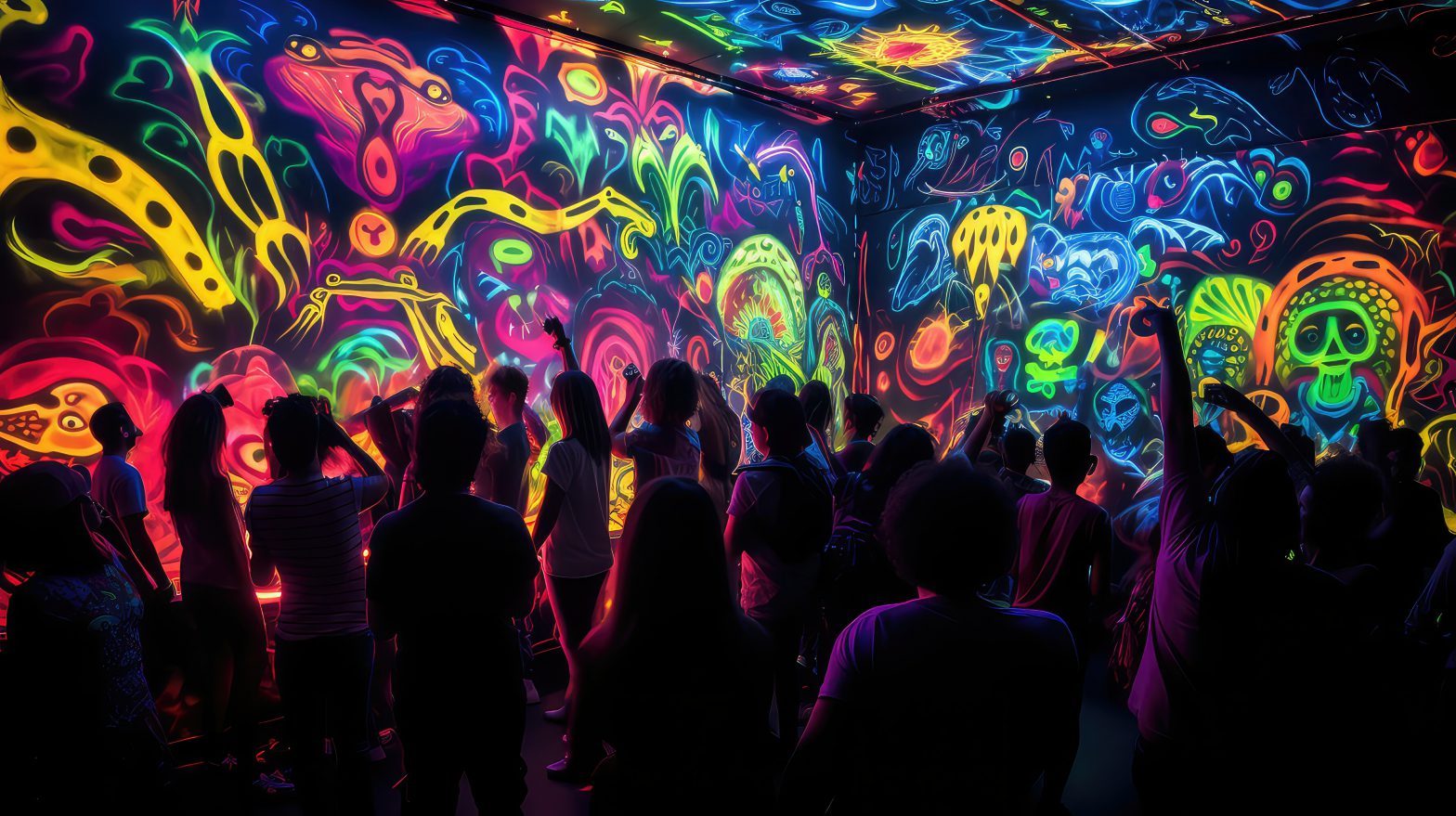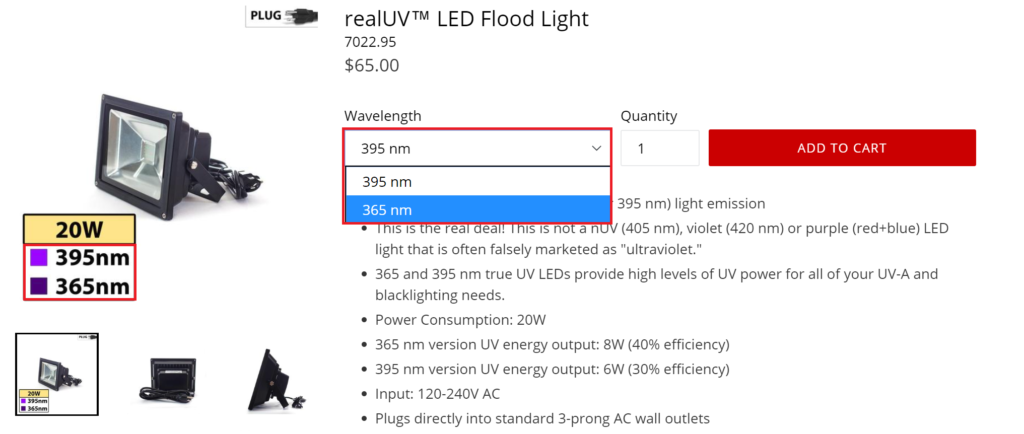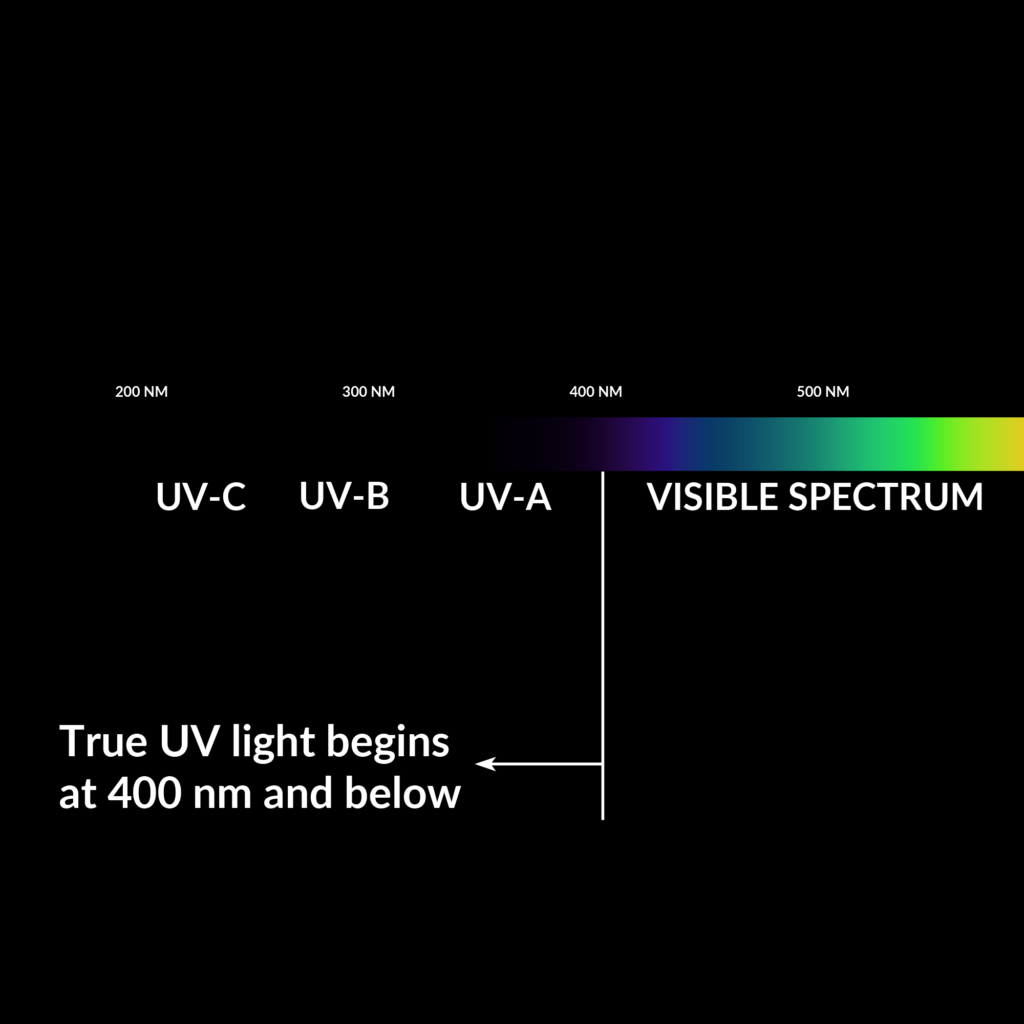
What is the Difference Between 365 nm and 395 nm UV LED Lights?
Home /
Blog /
Tech & Color Science /
What is the Difference Between 365 nm and 395 nm UV LED Lights?
If you're looking for some UV-A blacklights, you may come across two specifications - 365 nm or 395 nm. What does that mean, and which one is best? Read on to find out more!

Before we get into answering the question of whether 365 nm or 395 nm is better for your application, it is important to understand the basic principles of wavelength and light.
As you may recall, different wavelengths of visible light appear as different colors to us. 450 nanometer light, for example, is a royal blue color, while 630 nm is a punchy, red color. Light that has a wavelength between 400 nm and 800 nm is visible, while light that falls below 400 nm is considered invisible, ultraviolet light.

Even though lights at wavelengths below 400 nm are not visible to the human eye, the wavelength value is still nonetheless very important. For example, 365 nm wavelength UV belongs to a type of ultraviolet known as "UV-A," while 290 nm wavelength UV is considered "UV-B." The wavelength is what determines the type of UV, and this is an important distinction among UV category in terms of application and even safety precautions that are necessary.
At a basic level, then, you should note that 395 nm is about 30 nm closer to visible light (violet) than 365 nm is. Or, in other words, 365 nm is "deeper" into the UV spectrum than 395 nm is.
Both 365 nm and 395 nm options are within the UV-A wavelength range. Generally speaking, UV-A lights are useful for creating and observing fluorescence effects, as well as for plastics and paint curing. UV-A wavelengths are safer when compared to stronger UV-B and UV-C rays.
What then, will a difference of 30 nm mean?
The main difference is that the 395 nm LED emits much more visible light than the 365 nm LED. The 395 nm LED emits a pronounced violet-colored light, while the 365 nm LED emits a dull, bluish-white light (the result of residual light energy that "tails" off into the visible spectrum). Both types emit in the UV-A wavelength range and are generally capable of producing "blacklight" or curing effects.
Why is there a difference in the amount of visible light? The chart above shows the spectral output diagram of both the 365 nm (narrow dotted line) and 395 nm (wide dotted line) LEDs. What you will notice is that both 365 nm and 395 nm LEDs emit over a range of wavelengths both above and below their respective wavelengths. In other words, 395 nm LEDs don't emit at only 395 nm.
The 395 nm LED emits strongest at 395 nm (as defined by the term peak wavelength), but it also emits quite a bit of energy at 400 nm, and even 410 nm. These wavelengths are solidly in the visible, violet portion of the spectrum.
Of course, the 395 nm LED also emits at wavelengths below 395 nm as well, and the light energy at these wavelengths are very effective at creating fluorescence effects or initiating UV-A reactions. But, as the chart shows, it is important to notice that a significant portion of the light energy is being emitted in the visible, violet region.
Conversely, looking at the 365 nm spectral output, you will notice that virtually all of the light energy is within the invisible UV-A range only, with emission energy tailing off before reaching 400 nm. This will maximize the amount of UV-A energy compared to visible light energy and is preferred for most UV-A applications.
When illuminating a 365 nm LED, however, you will likely notice a dull, bluish-white color emitted. This is caused by visible light "leakage" where minuscule but visible amounts of visible wavelength energy (i.e. white light) are also emitted. The proportion of this visible light energy is so small that it is shown as "0" in the spectral charts, but in some applications such as UV photography, the visible light is indeed detectable and may be a nuisance. In such cases, additional visible light filtering techniques may be necessary.
In addition to 365 nm UV lights having the advantage of not emitting violet light, many objects will fluoresce strongest at 365 nm, as evidenced by absorption spectrum measurements.
The result is that 365 nm light may be better suited for applications where stronger fluorescence effects are desired. Coupled with the advantage of having a lower amount of visible, violet light emitted, 365 nm light can considered an optimal choice where performance is of paramount importance.
Due to the way LED diodes are manufactured, 365 nm wavelength chips tend to be less efficient and more costly. The exact difference in price will depend on the product type, but in general, 365 nm LEDs do come with a price premium, and as such, 395 nm LED products are better suited for those on a budget.
Waveform Lighting offers a variety of UV both 365 nm and 395 nm options for UV LED strip lights and UV flood lights. See below for purchase links.
realUV LED Flood Light
realUV LED Strip Lights

Back to Basics : Wavelength and Light
Before we get into answering the question of whether 365 nm or 395 nm is better for your application, it is important to understand the basic principles of wavelength and light.
As you may recall, different wavelengths of visible light appear as different colors to us. 450 nanometer light, for example, is a royal blue color, while 630 nm is a punchy, red color. Light that has a wavelength between 400 nm and 800 nm is visible, while light that falls below 400 nm is considered invisible, ultraviolet light.

Even though lights at wavelengths below 400 nm are not visible to the human eye, the wavelength value is still nonetheless very important. For example, 365 nm wavelength UV belongs to a type of ultraviolet known as "UV-A," while 290 nm wavelength UV is considered "UV-B." The wavelength is what determines the type of UV, and this is an important distinction among UV category in terms of application and even safety precautions that are necessary.
At a basic level, then, you should note that 395 nm is about 30 nm closer to visible light (violet) than 365 nm is. Or, in other words, 365 nm is "deeper" into the UV spectrum than 395 nm is.
365 nm and 395 nm for UV-A Applications
Both 365 nm and 395 nm options are within the UV-A wavelength range. Generally speaking, UV-A lights are useful for creating and observing fluorescence effects, as well as for plastics and paint curing. UV-A wavelengths are safer when compared to stronger UV-B and UV-C rays.
What then, will a difference of 30 nm mean?
The main difference is that the 395 nm LED emits much more visible light than the 365 nm LED. The 395 nm LED emits a pronounced violet-colored light, while the 365 nm LED emits a dull, bluish-white light (the result of residual light energy that "tails" off into the visible spectrum). Both types emit in the UV-A wavelength range and are generally capable of producing "blacklight" or curing effects.
Why is there a difference in the amount of visible light? The chart above shows the spectral output diagram of both the 365 nm (narrow dotted line) and 395 nm (wide dotted line) LEDs. What you will notice is that both 365 nm and 395 nm LEDs emit over a range of wavelengths both above and below their respective wavelengths. In other words, 395 nm LEDs don't emit at only 395 nm.
The 395 nm LED emits strongest at 395 nm (as defined by the term peak wavelength), but it also emits quite a bit of energy at 400 nm, and even 410 nm. These wavelengths are solidly in the visible, violet portion of the spectrum.
Of course, the 395 nm LED also emits at wavelengths below 395 nm as well, and the light energy at these wavelengths are very effective at creating fluorescence effects or initiating UV-A reactions. But, as the chart shows, it is important to notice that a significant portion of the light energy is being emitted in the visible, violet region.
Conversely, looking at the 365 nm spectral output, you will notice that virtually all of the light energy is within the invisible UV-A range only, with emission energy tailing off before reaching 400 nm. This will maximize the amount of UV-A energy compared to visible light energy and is preferred for most UV-A applications.
When illuminating a 365 nm LED, however, you will likely notice a dull, bluish-white color emitted. This is caused by visible light "leakage" where minuscule but visible amounts of visible wavelength energy (i.e. white light) are also emitted. The proportion of this visible light energy is so small that it is shown as "0" in the spectral charts, but in some applications such as UV photography, the visible light is indeed detectable and may be a nuisance. In such cases, additional visible light filtering techniques may be necessary.
365 nm for Strongest Fluorescence
In addition to 365 nm UV lights having the advantage of not emitting violet light, many objects will fluoresce strongest at 365 nm, as evidenced by absorption spectrum measurements.
The result is that 365 nm light may be better suited for applications where stronger fluorescence effects are desired. Coupled with the advantage of having a lower amount of visible, violet light emitted, 365 nm light can considered an optimal choice where performance is of paramount importance.
Difference in Cost & Efficiency
Due to the way LED diodes are manufactured, 365 nm wavelength chips tend to be less efficient and more costly. The exact difference in price will depend on the product type, but in general, 365 nm LEDs do come with a price premium, and as such, 395 nm LED products are better suited for those on a budget.
Waveform Lighting offers a variety of UV both 365 nm and 395 nm options for UV LED strip lights and UV flood lights. See below for purchase links.
realUV LED Flood Light
realUV LED Strip Lights
Other Posts
Browse Waveform Lighting Products
A-Series LED Bulbs
Our A19 and A21 lamps fit in standard lamp fixtures and are perfect for floor and desk lamp fixtures.
Candelabra LED Bulbs
Our candelabra LED bulbs offer soft and warm light output in a decorative bulb style that fits E12 lamp fixtures.
BR30 LED Lamps
BR30 lamps are ceiling lamps that fit in residential and commercial fixtures with 4-inch or wider openings.
